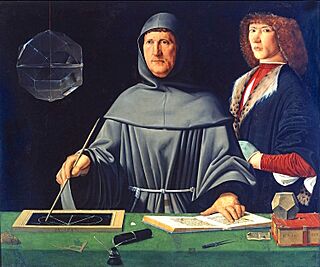Portrait of Luca Pacioli facts for kids
Quick facts for kids Portrait of Luca Pacioli |
|
|---|---|
 |
|
| Artist | Attributed to Jacopo de' Barbari |
| Year | c. 1495–1500 |
| Medium | Tempera on panel |
| Dimensions | 99 cm × 120 cm (39 in × 47 in) |
| Location | Capodimonte Museum, Naples |
The Portrait of Luca Pacioli is a famous painting from the Italian Renaissance. It was created around the year 1500. Today, you can see it in the Capodimonte Museum in Naples, Italy.
This painting shows a well-known mathematician named Luca Pacioli. Many people believe the artist Jacopo de' Barbari painted it. Some even think that Leonardo da Vinci, a very famous artist, might have helped paint parts of it. There is also another person in the painting whose identity is a bit of a mystery. It might be the German artist Albrecht Dürer.
Contents
Journey of the Painting
This painting was first written about in 1631. It was kept in the Ducal Palace in Urbino, Italy. Later, it moved to Florence. This happened because of Vittoria della Rovere, who was part of the royal families of both Urbino and Tuscany.
The painting was seen again in the 1800s. It belonged to a branch of the Medici family. The Italian government later bought the painting. They did this to make sure it stayed in Italy and was not sold to England.
What the Painting Shows
This artwork shows Luca Pacioli, who was a friar and a mathematician. He is sitting at a table filled with tools for geometry. You can see a slate, chalk, and a compass. There is also a model of a dodecahedron, which is a shape with twelve flat faces.
Hanging from the ceiling is another interesting shape called a rhombicuboctahedron. This shape is half-filled with water. It shows a detailed reflection of the Ducal Palace of Urbino. Pacioli is shown teaching a math idea from a book by Euclid. Another closed book in the painting has the words LI.RI.LUC.BUR. on it. This is thought to be his important book, Summary of arithmetic, geometry, proportions and proportionality.
Who is the Other Person?
The person standing on the right side of the painting has not been clearly identified. One idea is that it could be the German painter Albrecht Dürer. Dürer was interested in ideas about proportion, which he learned from Barbari. Dürer's notes show he met Barbari between 1495 and 1500. Barbari then introduced Dürer to Luca Pacioli's work on mathematics and art.
Dürer wrote in 1506 that he planned to travel to Bologna. He wanted to learn the secrets of perspective from someone there. Some of Dürer's drawings look like those by Pacioli's teacher, Piero della Francesca. Dürer might have learned about both artists through Pacioli's book Divina proportione. This book was illustrated by Leonardo da Vinci.
Ideas About the Learner's Identity
Many people have tried to figure out who the second person in the painting is. Here are some of the main ideas:
Guidobaldo da Montefeltro
One idea is that the person on the right is Guidobaldo da Montefeltro. He was the Duke of Urbino at the time. He loved studying mathematics. Pacioli's book, the Summa, was even dedicated to him.
Francesco di Bartolomeo Archinto
Another idea suggests the person is Francesco di Bartolomeo Archinto. There is a very similar portrait of him in the National Gallery, London. This other portrait is sometimes thought to be by Marco d'Oggiono or Giovanni Ambrogio de Predis, who were artists from Leonardo's school.
Galeazzo Sanseverino
A scholar named Carla Glori believes the person is Galeazzo Sanseverino. He was the son-in-law and a close friend of Ludovico il Moro, a powerful leader in Milan. Galeazzo was also a supporter of Luca Pacioli. This idea is based on comparing the painting to another portrait, the Musico by Leonardo. That painting is also thought to be of Galeazzo. Both portraits show similar features, like thick curly hair.
Other scholars have also pointed out how much these two portraits look like Roberto Sanseverino, Galeazzo's father. The features of their faces are very similar. This idea also fits with Luca Pacioli's connections in Milan around 1495. He worked with Ludovico and Galeazzo, and with Leonardo. By 1496, Pacioli was working on his book "De Divina Proportione." He was even a guest in Galeazzo's home.

